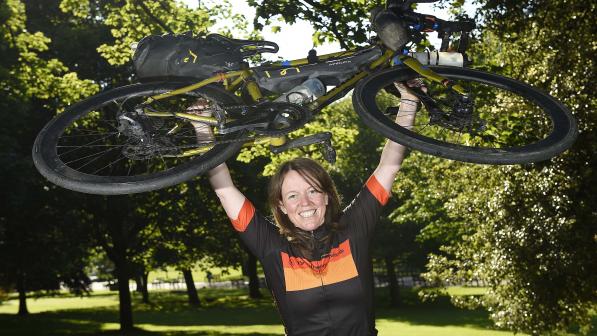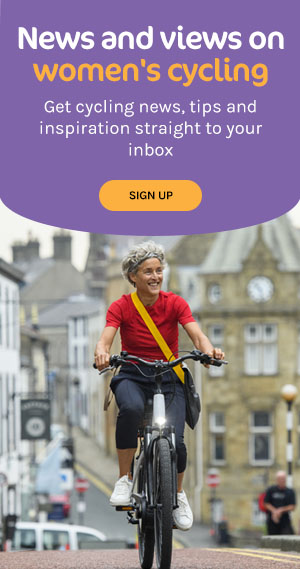Jenny Graham: Coffee First, Then the World

Well, we’re doing it, then. We’ve made it to the start…
I’m not one for getting overly gushy about bikes, but as I lay on the cool, unfamiliar white sheets, I appeared to be talking to mine. She hadn’t yet earned her name ‘Little Pig’ – that would come later – but the golden mustard steel frame of my Shand Stooshie bike had already become my companion. She’d been in my life for only four months, but during that time we had battled through snowstorms, crossed mountain ranges, skirted coastlines and spent every evening and weekend together, testing each other to the maximum as we trained and prepared for the Round the World project.
I looked her over. Every bolt on her chassis was familiar. Every component she held had weeks and months of thought put into it. With every decision came a list of pros and cons – durability versus weight versus price versus necessity versus mend-ability. She didn’t hold one item that hadn’t been meticulously considered.
The cockpit I’d set up on the handlebars would become my home – my front room and kitchen – for the next four months, holding all I’d need to navigate, collect data, charge equipment, light my way, carry clothes and food, and rest my weary body.
From the handlebars I’d attached aerobars, which sat proud both vertically and lengthwise. These were my armrests, with short poles that flipped up at the end for comfort. The poles were hollow and inside them I’d rolled up six different currencies in case of emergencies, to see me through the first leg of the route from Berlin to Beijing: euros for Germany, Latvia and Lithuania; zloty for Poland; roubles for Russia; tögrög for Mongolia; and renminbi for China. I also carried US dollars. I wouldn’t need them for a long time, but they would be a good backup, because most places in the world recognise their value.
My friend Colin, from Craigdon Mountain Sports, had sacrificed the length of the shop floor’s broom handle and sawn two small chunks from the top to wedge in between the bars. I then wrapped them up with tape – the perfect bodge. These would act as shelves and together with my bars, they would carry my essentials: my lights, a camera, a huge elastic hair band to stuff things under, my GPS Tracker, two water bottle cages with bottles, two wired speed sensor computers and my main GPS navigation tool – the Garmin Edge 1000.
I’d bought the GPS with the money I’d received from my very first sponsor, Evans Cycles, back in November 2017. They paid me £500 in return for three blog posts about preparing for my World Record attempt. I would need to raise a whole lot more than that, but it was a start and it represented a glimmer of hope amongst the piles of rejection emails I’d received from other brands and businesses.
That GPS would guide me the whole way around the world. Or at least it would if I actually downloaded any routes. I hadn’t. I had thought about doing it lots of times and had even practised how, but had kept putting it off. It was a sit-down job; one I thought I’d do in the airport or sometime where there was a period of enforced rest, but there were always so many more pressing jobs to do and I’d never got to that point.
In only six hours’ time I was due to start the ride of a lifetime. A World Record attempt to become the fastest woman to circumnavigate the planet by bike. I’d need to ride 29,000 km – or 18,000 miles – all on my own, over four continents and through 16 countries, and I’d just realised that I didn’t even know the way out of Berlin.
The next hour passed in a fury of tech faffing. The routes were all saved on my Strava account and in my Dropbox as a back-up, but an issue with the Wi-Fi in the flat meant the routes wouldn’t upload the way they had when I’d practised. I couldn’t figure out what had gone wrong and instead panicked, assuming this was my tech incompetence.
Thomas Hogben and Mike Webster, both filmmakers, were in the next room. They had come out with me to Germany to film the start, in the hope that I’d make it far enough self-shooting for them to make a documentary.
I woke them up. Using his laptop, Tom eventually managed to download half the world on to a SIM card that I then plugged into my Garmin GPS. The issue was temporarily fixed, but it had just triggered every single fear and internal battle I’d had with myself about my ability to actually pull this off.
I was overcome by self-doubt, like I’d finally just proved to myself that I wasn’t cut out for this World Record and was completely out of my depth. I returned to bed, replaying the time I had spent practising the uploads, internally beating myself up for not doing the job properly. I weighed up the likelihood of there being other, finer details of the trip I had also forgotten.
My alarm went off a few hours later. I opened my eyes and stared at the ceiling with my brow still furrowed and my jaw clenched. My chest was so heavy it felt like it was physically pinning me to the mattress.






